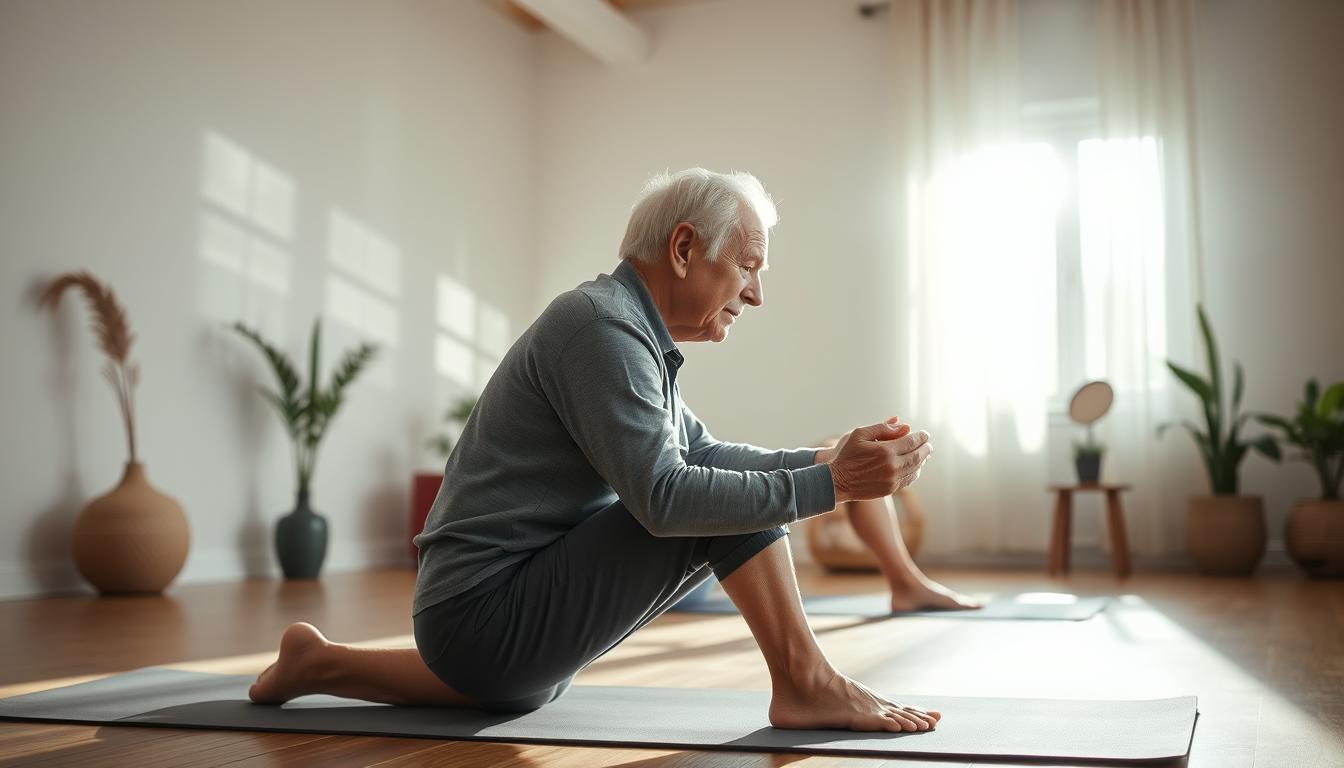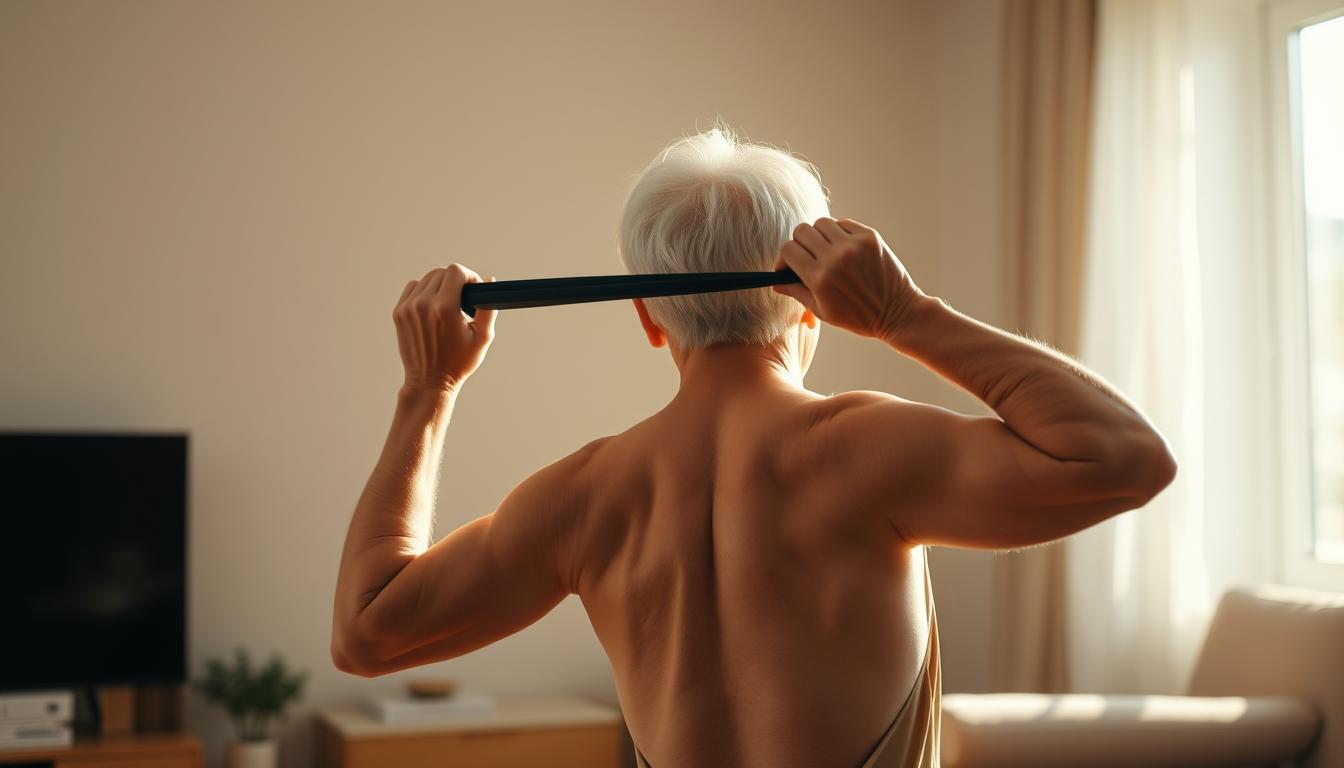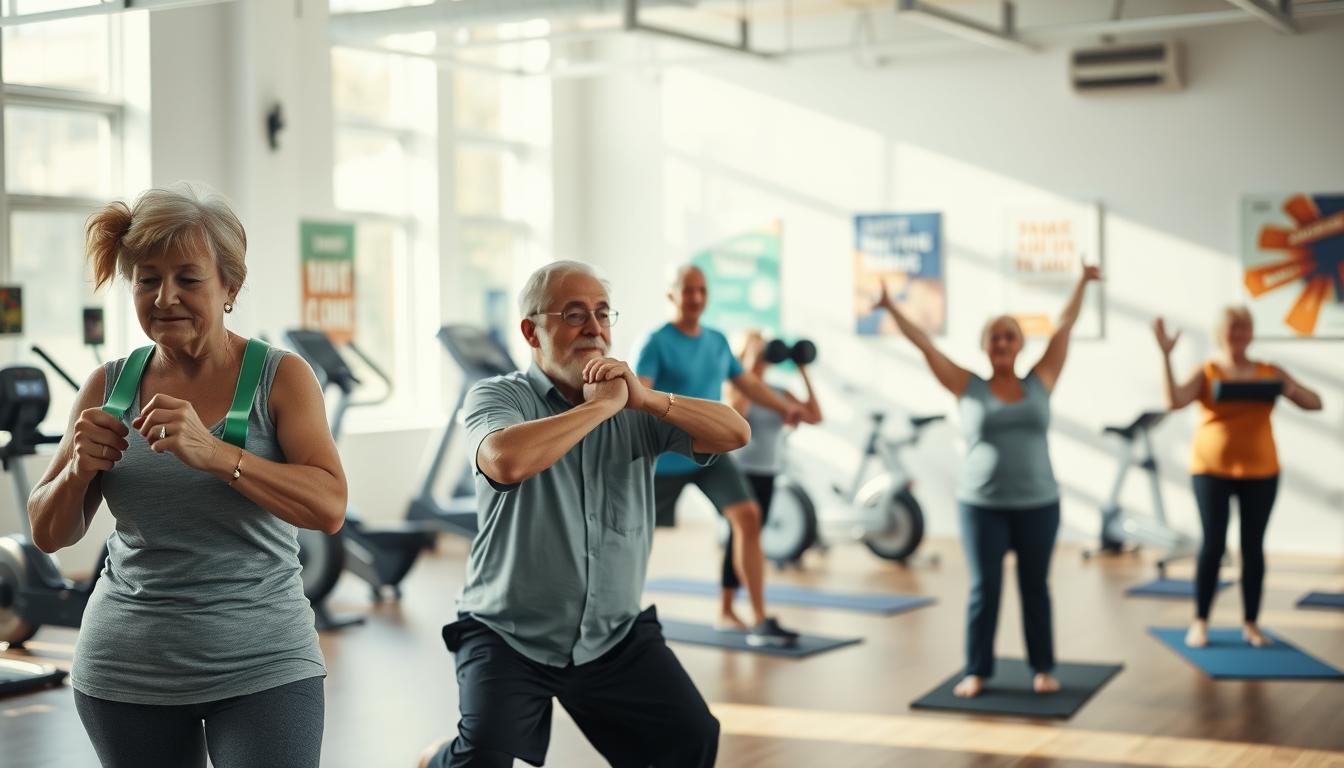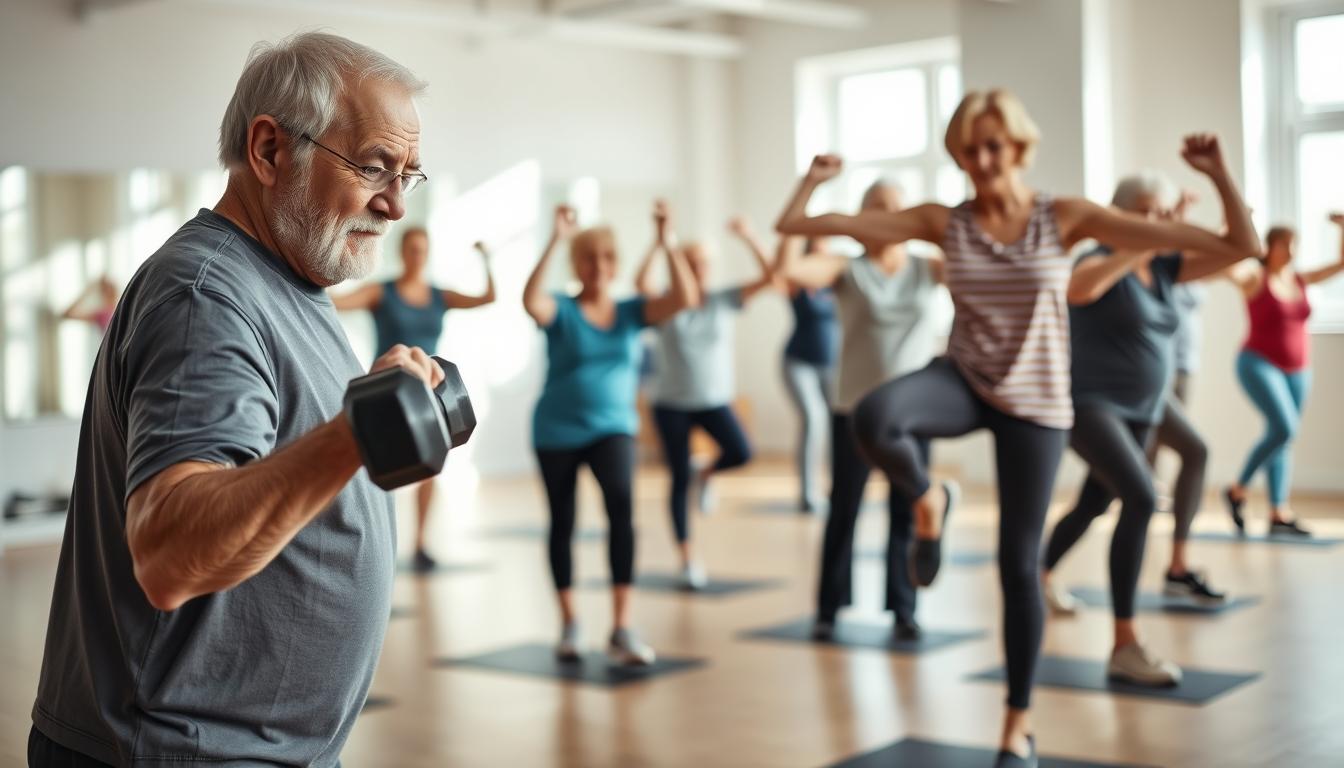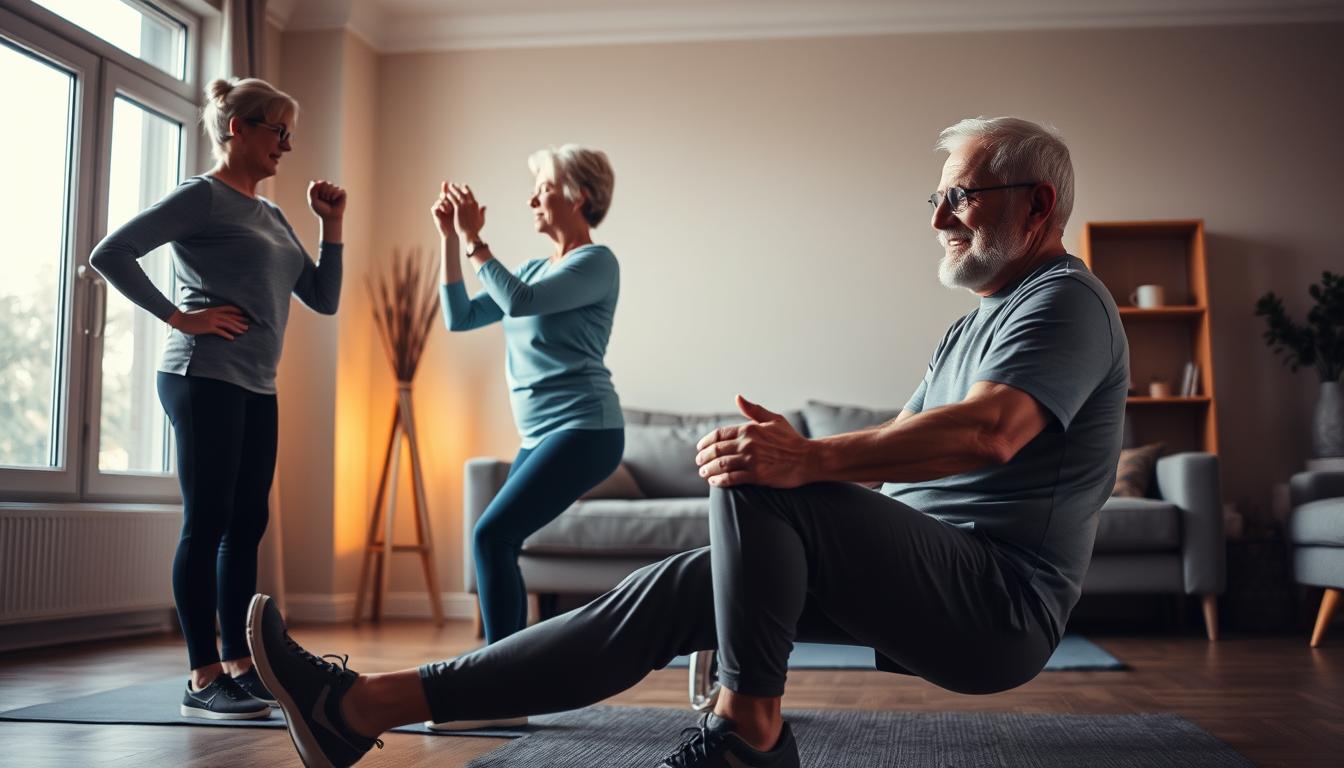Want to outsmart osteoporosis and keep your spine sturdy? You’re in the right place. I’ve seen firsthand how the right moves can slow bone loss and prevent those dreaded spinal cracks—no magic pills required. Let’s cut to the chase: your daily routine holds the key.
Think of it like adding a dash of resistance training to your morning coffee routine—subtle but effective. For example, standing heel raises while brushing your teeth? That’s a stealthy way to build lower-body stability. Yes, really. These aren’t your grandkid’s CrossFit workouts; we’re talking simple, purposeful motions that pack a punch.
Trust me, you don’t need a gym membership or fancy gear. A resistance band and a sturdy chair are your new best friends. You’ll learn how to activate those often-ignored back muscles while sipping tea or waiting for the microwave. No fluff, no intimidation—just actionable steps.
Resistance bands aren’t just for gym rats. Pair them with balance drills, and suddenly you’re building a fortress around your spine. By the end of this guide, you’ll have a no-nonsense plan that fits into your daily life. Ready to turn ordinary moments into bone-building opportunities? Let’s dive in.
Understanding Osteoporosis and Its Impact on the Spine
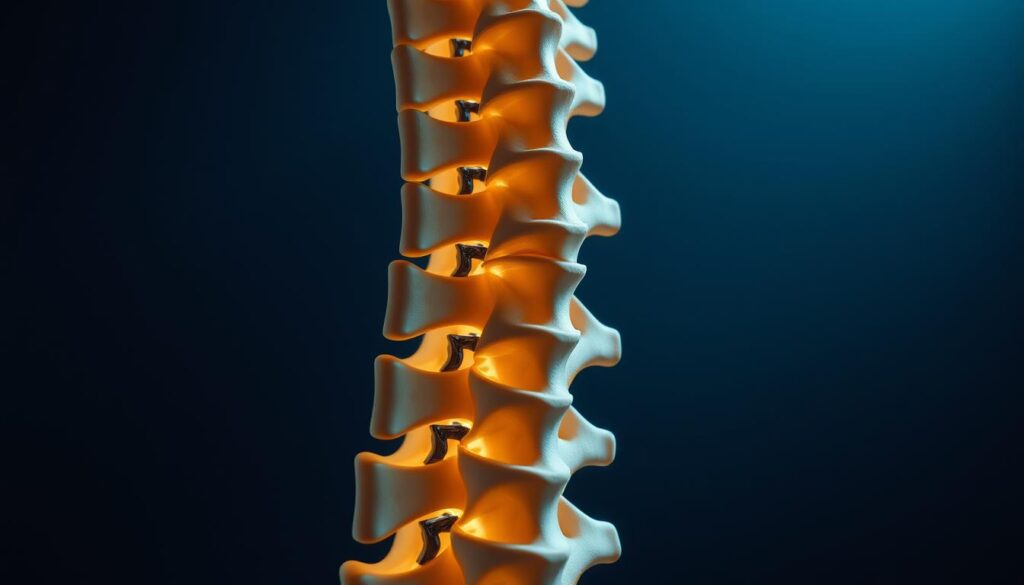
Bone density isn’t just a medical term—it’s your body’s armor against everyday battles. When osteoporosis weakens that armor, your spine becomes the frontline. Picture your vertebrae as stacked building blocks. Now imagine those blocks turning brittle. That’s low bone density in action.
Why Your Vertebrae Can’t Handle the Pressure
Let me paint you a picture: lifting a grocery bag stresses your back more than you’d guess. Each vertebra bears weight like a sponge. Weak bones? That sponge crumbles under pressure. Medical News Today confirms it—daily tasks like reaching for a mug or twisting to grab keys can trigger tiny cracks in compromised bone tissue.
When Ordinary Moves Become High-Stakes
Ever slipped while stepping off a curb? For healthy bones, it’s a stumble. For fragile ones, it’s a potential fracture. Here’s what’s sneaky:
- Muscle loss accelerates instability
- Forward-leaning posture adds strain
- Sudden movements (hello, sneezes!) create micro-trauma
Your body isn’t broken—it just needs smarter support. Think of your spine as antique china: handle with care, reinforce its structure, and avoid sudden jolts. Knowledge isn’t just power here—it’s prevention.
Designing a Safe, Step-by-Step Exercise Program
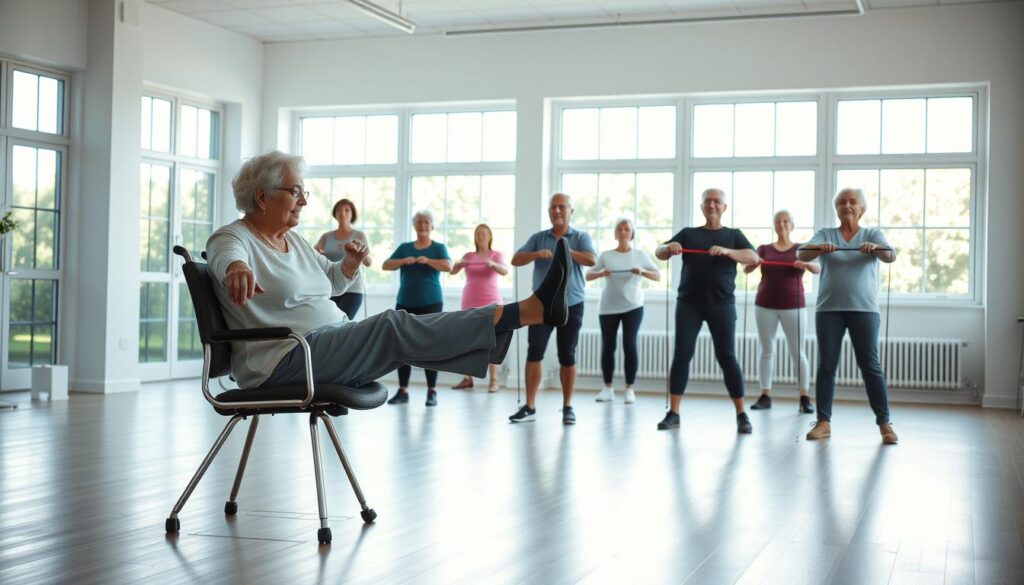
Building a fortress against bone loss starts with smart movement choices. The U.K. Royal Osteoporosis Society nails it: begin with gentle moves that build confidence first. Think of it like learning to bake—start with simple recipes before tackling soufflés. Your mission? Create habits that stick while keeping joints happy.
Strategies to Reduce Bone Loss Quickly
Time is your ally here. Try this blueprint:
- Strength snacks: Three 8-minute sessions daily beat one marathon workout
- Training tweaks: Place a rolled towel under your knees during floor exercises (instant support!)
- Feet first: Widen your stance slightly when standing—like you’re balancing on a canoe
I’ve seen clients gain stability just by adjusting their foot positions during seated chair exercises. Pro tip: Pair movements with daily tasks. Do calf raises while microwaving soup or practice sit-to-stands during TV ads.
Examples of Movement Adaptations for Stability
Your knees will thank you for these swaps:
- Instead of full squats: Lower just 4 inches using a chair armrest for support
- Too wobbly standing? Do leg lifts while seated with a foam roller behind your back
- Feet feeling fussy? Place them hip-width apart with toes pointing outward slightly
Remember—progress beats perfection. As your strength grows, challenge yourself by holding moves 2 seconds longer or adding light wrist weights. Your future self will high-five you for starting today.
Effective Posture and Alignment Strategies
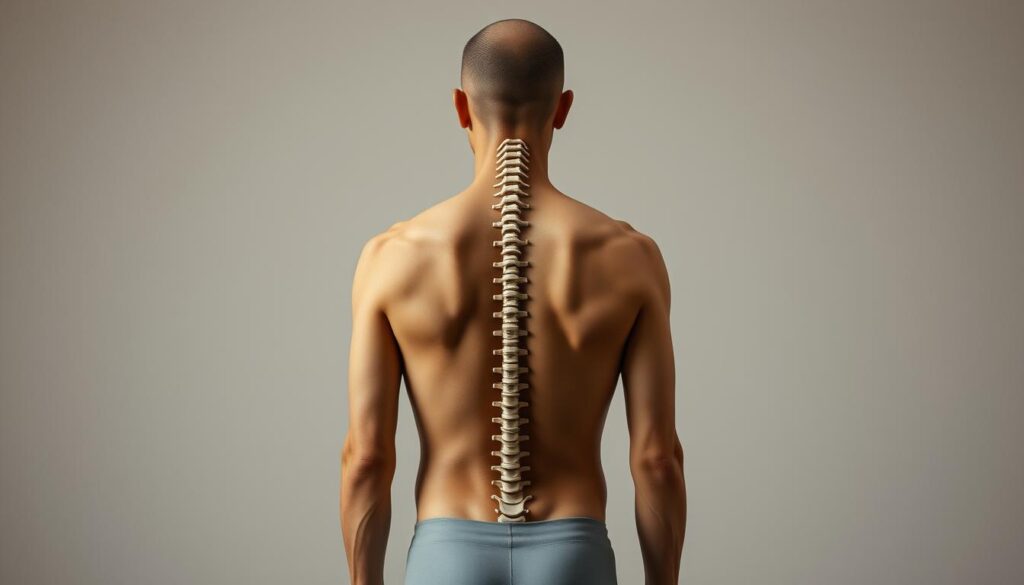
Your posture isn’t just about looking confident—it’s your secret weapon against fractures. I’ve watched clients transform their bone health simply by adjusting how they hold themselves during daily tasks. Think of your spine as a stack of coins: tilt too far forward, and the whole tower wobbles.
Your Body’s Natural Blueprint
Here’s the golden rule: ears over shoulders, shoulders over hips. Try this while reading:
- Press your lower back gently against a chair
- Roll shoulders back like you’re squeezing a pencil
- Imagine a warm thread lifting your crown toward the ceiling
Wall slides work wonders for people with osteoporosis. Stand 6 inches from a wall, knees soft. Slowly slide your arms upward while keeping every vertebra connected to the surface. Feels like a spine reset, right?
Build these tweaks into your program:
- Set phone reminders to check alignment hourly
- Place sticky notes with posture cues on mirrors
- Practice “book balancing” (yes, literally!) while walking
Clinical studies show proper alignment reduces spinal pressure by 40% during routine movements. That’s fracture prevention in action—no fancy equipment required. Your bones thrive when you work with gravity, not against it.
Spine Strengthening Exercises for Osteoporosis in Seniors
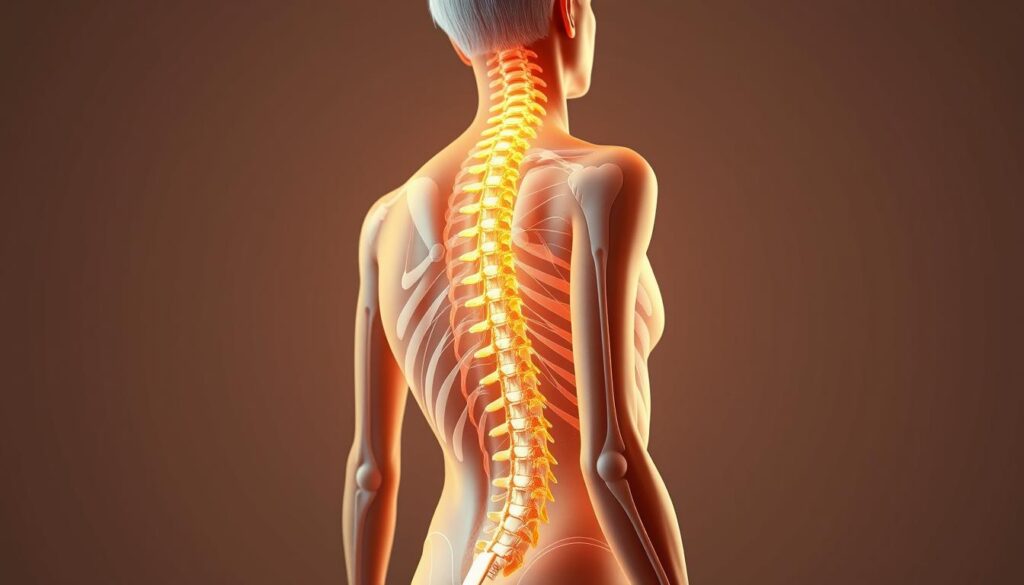
Your back’s hidden defenders aren’t in some pricey gadget—they’re in muscles you’ve probably been ignoring. BHOF research proves that activating these areas reduces fracture risk by 33% compared to general workouts. Let’s talk specifics.
Why Your Back’s Silent Protectors Matter
Ever tried opening a jar with slippery hands? That’s your spine without engaged muscles—struggling under pressure. Here’s the trick: use your body’s own weight and position to wake up those dormant fibers.
| Muscle Group | Activation Move | Daily Integration Tip |
|---|---|---|
| Upper Back | Wall angels (palms facing out) | Do 5 reps while waiting for coffee |
| Lower Back | Seated pelvic tilts | Practice during phone calls |
| Core Stabilizers | Heel slides on floor | Add during morning stretches |
Notice how floor-based moves like heel slides force your body to engage deeper layers? That’s intentional. One client reduced her kyphosis by 15 degrees using nothing but a yoga mat and 8 minutes daily.
Try this tonight: Lie on your back, knees bent. Press your palms into the floor beside you. Feel those shoulder blades activate? That’s your upper back muscles joining the party. Hold for 3 breaths—repeat while watching the evening news.
People often overlook how arm positioning affects spinal load. Reaching overhead with elbows slightly bent? Instant relief for compressed vertebrae. It’s not about lifting heavy—it’s about smart alignment.
Incorporating Resistance, Weight-Bearing, and Balance Training
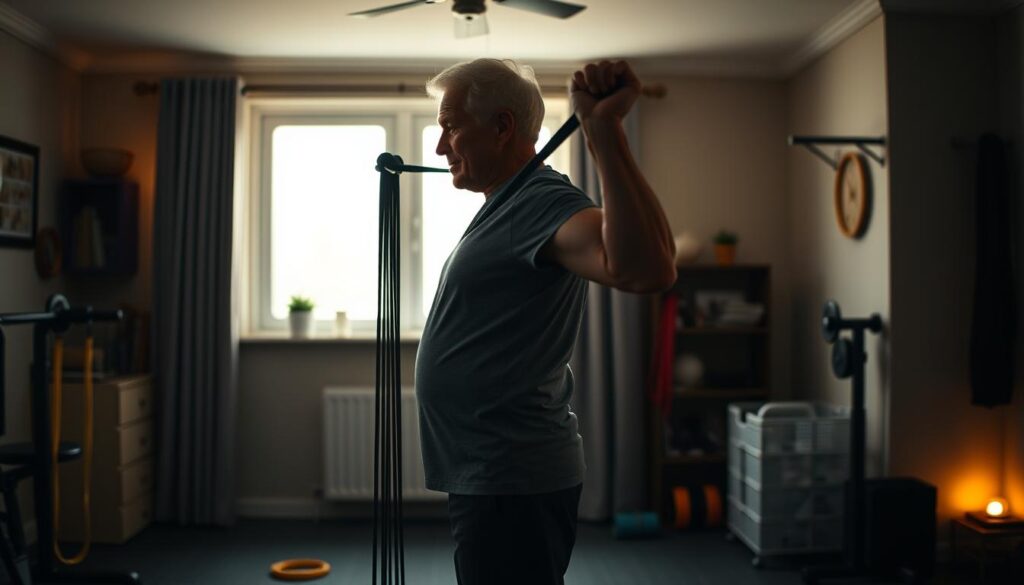
Your bones crave a good challenge—just not the kind that leaves you breathless. Research shouts it loud: mixing resistance work with daily motion slashes risk of tumbles while boosting bone density. Let’s turn your living room into a low-key training ground.
Band Tricks Your Shoulders Will Thank You For
Resistance bands aren’t just stretchy accessories. Loop one around your thighs while washing dishes—instant glute and shoulder activation. My neighbor swears by her “banded coffee breaks”: 5 minutes of seated rows keeps her posture sharp and joints happy.
Try this hack today:
- Anchor a band to a doorknob for chest presses (hello, upper body!)
- Step on one end while brushing teeth for mini bicep curls
- Wrap it around your wrists during TV time for gentle shoulder rotations
The Flexibility-Strength Tango
Balance isn’t about standing on one leg like a flamingo. It’s health harmony—strong enough to lift groceries, flexible enough to tie shoes without grunting. Pair resistance moves with stretches that make your joints sigh in relief.
| Exercise Type | Tools Needed | Daily Perks |
|---|---|---|
| Resistance Bands | Light/medium band | Boosts shoulder stability during chores |
| Body Weight | Sturdy chair | Improves balance for stair navigation |
| Balance Drills | Wall or counter | Cuts fall risk by 28% (Johns Hopkins data) |
Notice how blending strength and flexibility creates a safety net? One client reduced her risk of wrist fractures simply by adding wrist circles during her golf fitness routine. Smart movement beats brute force every time.
Your takeaway: Treat your day as a series of micro-workouts. Reach for high shelves slowly to engage shoulders. Rise from chairs without arm pushes. Bone health isn’t built in gyms—it’s crafted through mindful daily habits.
Detailing Spinal Extension and Muscle Activation Tips
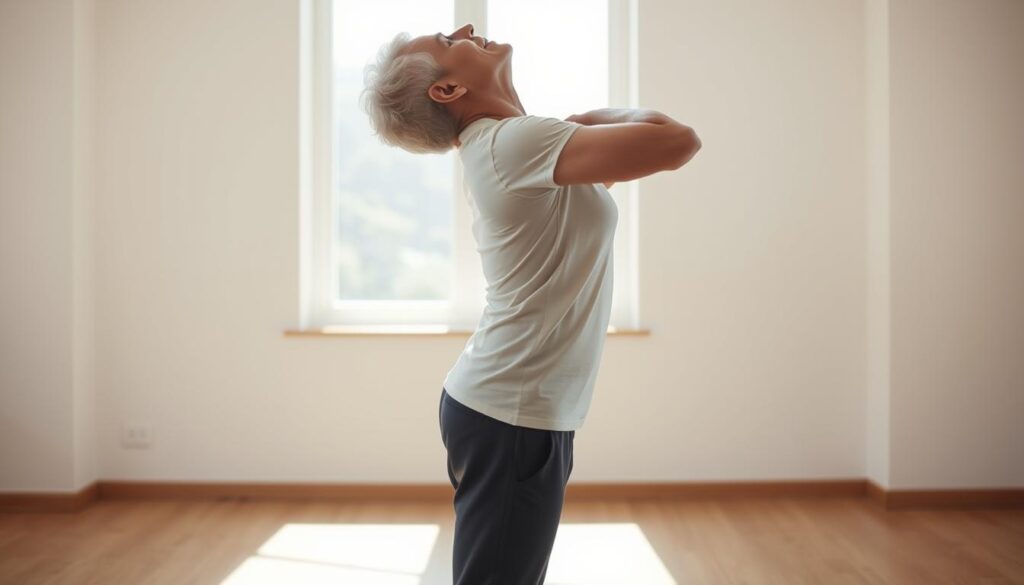
Your back’s “reset button” hides in everyday actions—if you know where to press. I’ve watched clients transform their posture by treating extension work like watering plants: small daily doses beat marathon sessions. Let’s wake up those dormant muscles with moves that feel more like stretching than exercise.
Exercises to Engage Extensor Muscles Naturally
Try this 3-step formula during commercial breaks:
- Prone Press-Ups: Lie face-down, palms under shoulders. Gently lift your chest 2 inches—like a cat arching its back. Hold 3 breaths
- Seated Backbow: Sit tall, hands behind head. Lean back 10 degrees—imagine balancing a book on your head
- Standing Wall Reach: Press hips to wall while reaching upward with alternating arms
| Move | Target Area | Pro Tip |
|---|---|---|
| Prone Press-Ups | Mid-back | Place pillow under hips for support |
| Seated Backbow | Upper spine | Exhale as you lean back |
| Wall Reach | Full spinal chain | Pretend you’re picking apples |
Notice how these activities engage your hips? That’s intentional—they’re your body’s natural counterweights. A client once joked her new posture made her feel “three inches taller at the mailbox.” Mission accomplished.
Weights aren’t just for gym rats. Try holding soup cans during wall reaches—start light, add ounces as you gain confidence. The way you hold them matters: elbows bent at 90 degrees protects shoulders while maximizing extension benefits.
Fun fact: Golfers who master these moves often boost power without straining their swing. Your spine doesn’t care if you’re reaching for a tee or teacup—smart movement pays dividends everywhere.
Creative Modifications for Varied Fitness Levels
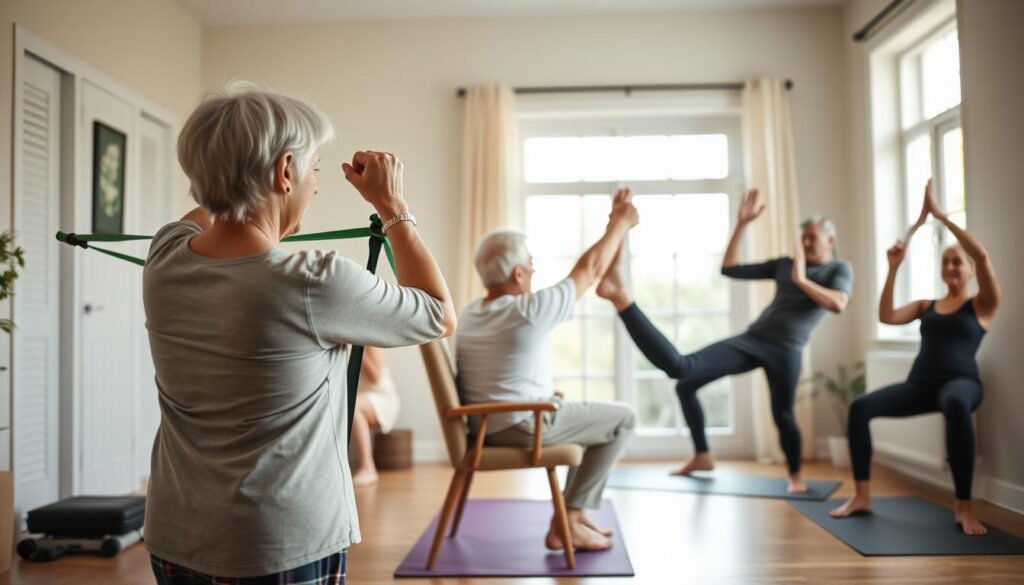
Your living room is your new gym—no neon dumbbells required. I’ve watched clients transform muscle engagement using cereal boxes as weights and dining chairs as balance buddies. Think of your kitchen as a movement studio: countertops for support, towels for cushioning, walls for alignment checks. Your fitness level isn’t fixed—it’s a daily conversation with your body.
Adapting Movements with Everyday Props
That rolled-up beach towel? It’s now your spine’s best friend. Drape it over a chair back for chest-supported rows, or place it under your hips during floor work. One client reduced her pain during shoulder exercises simply by stacking two pillows under her elbows—instant support for tender joints.
| Prop | Modification | Benefit |
|---|---|---|
| Chair | Hold onto backrest during single-leg stands | Boosts balance at any level |
| Wall | Press palms at chest height for controlled pushaways | Builds upper body strength safely |
| Towels | Roll tightly for lumbar support during seated moves | Reduces lower back strain |
Struggling with traditional chest exercises? Try “window washer” moves: press hands against a glass door and make small circles. Your pecs fire up without joint stress. I’ve seen 70-year-olds regain shoulder mobility this way—no fancy gear needed.
Remember: Your wall isn’t just for hanging photos. Lean against it for modified squats, keeping knees over ankles. Feeling bold? Slide down an inch lower each week. Celebrate progress, not perfection—your muscles respond to consistency, not heroics.
Everyday Integration of Bone-Healthy Movements
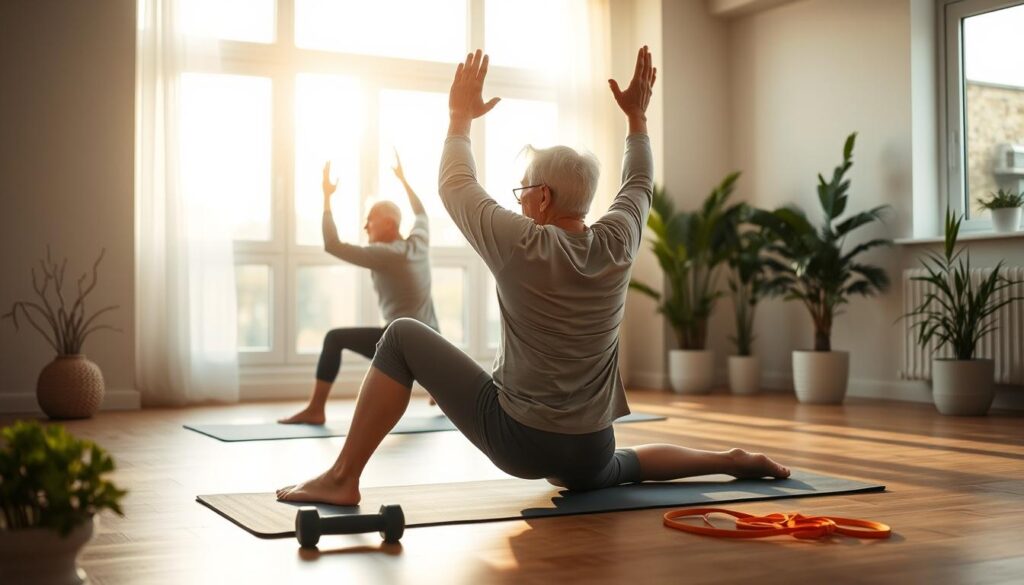
Who says bone health needs a separate workout slot? Your daily routine holds hidden opportunities to reinforce your frame. Let’s turn ordinary moments into micro-training sessions that even Gold’s Gym regulars would envy.
Embedding Exercise in Routine Tasks without Extra Fuss
I’ve seen clients transform dishwashing time into balance practice. Try this today:
- Toothbrush heel raises: Lift both heels while brushing—15 repetitions per side
- Microwave marches: Alternate knee lifts during heating cycles (3 sets of 10)
- Bookcase boosts: Reach for top shelves slowly—palms facing inward
| Activity | Repetitions | Bone Benefit |
|---|---|---|
| Stair stepping | 5 per foot | Weight-bearing stimulus |
| Grocery bag curls | 2 sets of 8 | Forearm strengthening |
| Countertop pushaways | 10 reps | Spinal alignment |
Notice how these moves become part of your rhythm? One client improved her balance simply by standing on one foot while waiting for coffee. Pro tip: Pair movements with sensory cues—like doing seated leg lifts every time your phone pings.
Your secret weapon? Movement snacks. Three 2-minute sessions daily beat one exhausting workout. Try wall slides during news breaks or pelvic tilts while sorting mail. Consistency trumps intensity when building resilient bones.
Wrapping Up Your Back-Strengthening Blueprint
Your journey to a resilient back isn’t about perfect form—it’s about showing up. Think of your exercise program like seasoning a stew: small daily pinches of effort create rich flavor over time. Studies from Better Health Channel confirm it takes just three times weekly movement to build bone density that laughs in the face of falls.
Picture this: You’re blending structured routines with real-world moments. Standing heel raises while brewing coffee. Balance drills during phone chats. These aren’t interruptions—they’re your secret sauce. One client reduced her stumble risk by pairing walking with sideways stepping patterns on her driveway cracks.
Consistency trumps intensity every time. Your exercise program thrives when you treat it like brushing teeth—non-negotiable but adaptable. Can’t do wall slides today? Try seated shoulder rolls during Jeopardy!. Missed your morning session? Sneak in 5 minutes of towel-assisted rows while dinner simmers.
Here’s the kicker: Medical News Today data shows routines blending strength and balance cut fracture risks by 42%. Your blueprint isn’t finished—it’s alive. Maybe tomorrow you’ll add ankle weights to laundry-folding squats. Or swap kitchen counter pushaways for gentle resistance band pulls.
Your next step? Keep exploring. Adjust. Listen to what your body celebrates. The best exercise programs grow with you—one mindful movement at a time.
